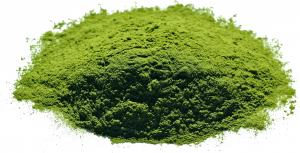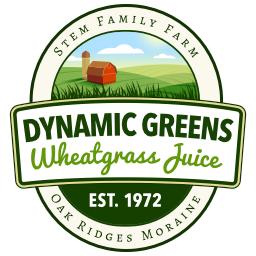 Wheatgrass powder and tablets have only a fraction of the bioactivity of the juice and should be avoided.
Wheatgrass powder and tablets have only a fraction of the bioactivity of the juice and should be avoided.
There are an extraordinary number of wheatgrass and barley grass products that are available to the consumer. If you want to get a sense of how many, get the book Wheatgrass -Nature’s Finest Medicine by Steve Meyerowitz for extensive details.
We believe that the format you choose is really important. In particular, we think it needs to be alive. I’d like to discuss the formats a little further in order of preference:
Frozen Wheatgrass Juice: Best Approach
Here are the decision making criteria that we believe are important:
- Look for outdoor grown wheatgrass because it is clean, which means no detectable molds, better taste and no adverse reactions
- Always seek juice first because it is a living product
- Avoid anything processed to have a shelf life
- Make sure it is packaged in a way that it is distanced from it’s natural enemies which are air, heat and light and this keeps it in great shape
As we grow using organic methods, we experience a high degree of variability in the crop. This means that when we harvest the juice, we continually sample for taste and intensity (spectrophotometer). In the course of doing this, it is not uncommon for several people to drink 20 fl. oz. or more of the juice during a harvesting day. This is fresh juice coming directly from our fields, drank on the spot and here’s the critical point…with this fresh juice right from the field, no one has ever experienced the negative “detoxifying” effects associated with what people sometimes refer to as fresh wheatgrass (greenhouse grown wheatgrass coming from trays). These detoxifying effects are a myth and the reactions are caused by moldy grass. Our wheatgrass does not cause these effects because growing the wheatgrass outdoors results in grass and juice with no detectable molds.
The process that we use to maintain the quality of the juice is called flash freezing. In flash freezing, intense cold is applied to the juice in order to freeze it rapidly. This causes only small ice crystals to form. Small ice crystals do not rupture cell membranes and this keeps the color, taste, texture and nutrition intact. This process allows us to capture a clean, living, natural product and distance it from its natural enemies (air – heat – light). Our flash frozen wheatgrass juice is made to the best of our ability and without compromise.
Pros:
successful health experiences attributed directly to our juice, long slow growing cycle, raw & living, good taste, no mold issues, usable in large amount over long periods of time, no management or cleanup or waste
Cons:
must be kept frozen so it doesn’t work well for business travellers
Fresh Wheatgrass Juice: Second Best Approach
In a perfect world, fresh juice available all the time would seem to be the preferred choice. People have frequently talked about the important of freshness in the juice. We agree with this belief (that is why we flash freeze instead of slow freeze the juice) as the juice oxidizes quickly.
As you research wheatgrass juice on the Internet, you are going to read about many problems people have experienced with fresh juice. These problems include:
- terrible taste
- dizziness
- headaches
- nausea
The problems are not a product of wheatgrass juice. These are a product of growing environments which promotes mold growth in the grass. The mold comes from ungerminated seeds in the soil rotting and which allows fungi to flourish. These fungi release something called mycotoxins which are believed responsible for these effects. The entire process is sped up by hot environments.
The reaction people have are often referred to as the “detoxifying” effects of wheatgrass juice. This is a myth. These problems occur with tray grown and greenhouse grown wheatgrass loaded with mold. In fact, even many outdoor environments are problematic in the summer. These problems simply disappear when you grow outdoors in a region hospitable to wheat.
Pros:
health successes reported, raw & living, freshest format, widely available at juicebars everywhere, inexpensive (but very time consuming) if you grow your own
Cons:
mold issues, bad taste, negative side effects, short growing cycle, not usable in large amounts over long periods of time, high levels of management and cleanup required, extensive waste
Freeze Dried Wheatgrass Juice: Third Best Approach
The objectives here are terrific and two-fold:
- Preserve the product without heat to try and retain its nutrition
- Make it considerably smaller to ease it’s handling and transport on every level.
The basic process involves juicing -> freezing -> freeze drying -> packaging with inert gas. It is however, a little more complicated in practicality. There are a lot of variables to control and you can read more about this at Wikipedia. The link is https://en.wikipedia.org/wiki/Freeze_drying.
There are a few areas that generate questions:
- Slow freezing is normally used because this creates large ice crystals. This is normally used because large ice crystals are easier to freeze dry. When slow frozen, the juice maintains contact with its primary enemy, air. In addition, the large ice crystals that form rupture cell membranes and compromise color – taste – texture and nutrition.
- It is expensive and customers do not have the education to understand why when there are 2 products in a bottle that one costs 2x or 3x more. This makes is a slow moving product and even worse, there are so many steps involved and so much energy used that the actual cost is far higher than 3x more. This makes it very hard financially on the providers. I just looked at a competitors site which produces 15 different bottle of powder and only 2 of them are freeze dried. Plus, because the yield is so low, this particular one has been boosted by adding 20% filler.
- Once the bottle has been opened, the level of preservation created by using an inert gas is gone and the crystals are back to being in the presence of oxygen.
Pros:
supposed to be bio-active, made from juice so it should be far better than powder, small and easy to transport, reasonably priced for the amount of investment required
Cons:
easily confused with powder (see below), efficacy unknown, many processing steps, entire contents compromised after opening
Wheatgrass Powder: Not Recommended
Powders made from chopped grass have very different properties than juice.
While powders make terrific economic sense for the producers, we do not believe they offer you much. The reason being that it takes a massive amount of wheat grass to make just a small amount of juice. However, it takes just a small amount of chopped grass to make a large amount of powder.
Sometimes these products are referred to whole leaf which would lead you to believe that it may be more complete. The problem with wheat grass itself is that the human body cannot digest grass itself so it needs a hand. The juicing process, which is done by masticating juicers simulates the process of chewing on a level far beyond what we are capable of. This process separates the juice from the indigestible fibres so that it is available to you.
Powders also need to be dried to remove enough moisture to make them last in a packet or bottle that can sit on the shelf. The exposure to air and heat often associated with this process damages the nutrition in it. So as a product, these are ones to be avoided because the nutrition is compromised and what remains is very difficult to digest and assimilate.
Pros:
inexpensive, widely available, simple to use and transport
Cons:
processed and dead, indigestible, health improvement association difficult or impossible to make, sources usually unknown, filler content unknown, often mixed with fillers for taste
Wheatgrass Tablets: Not Recommended
This is just a press form of powder which is described above.
Green Drinks With Wheatgrass As An Ingredient: Not Recommended
In our grocery stores in Canada, you can find several different “greens” drinks.
These will normally show contents on the label like wheatgrass, spirulina, kelp and many others. It sounds fantastic, but when taste these drinks, you will immediately recognize that they are really pineapple or white grape juice drinks with a splash of green powder for color. They are also pasteurized.
If you like the taste and don’t mind the sugars, by all means go ahead. Just don’t expect to get your nutrition this way!
